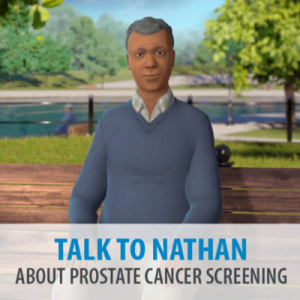Talk to Nathan About Prostate Cancer Screening and Treatment
Posted on byCDC, Division of Cancer Prevention and Control

We’ve probably all been confused at one point or another about cancer screenings and treatment. It’s not always easy to understand when to get what test and how often screening tests are needed. This is particularly true with screening for prostate cancer and treatment if screening finds cancer. This may vary from one man to the next. This process may be overwhelming and emotional.
First, let’s look at some prostate cancer basics:
- Not including skin cancer, prostate cancer is the most common cancer in American men.
- All men are at risk for prostate cancer. Out of every 100 US men, about 13 will get prostate cancer during their lifetime, and about 2 to 3 of these men will die.
- The most common risk factor is age. The older a man is, the greater his chance of getting prostate cancer. African American men and men with a family history of prostate cancer are at increased risk for getting prostate cancer or dying from it.
- Prostate cancer has a wide range of symptoms. Some men have no symptoms at all.
- There is no standard test to screen for prostate cancer. Two tests that are commonly used to screen for prostate cancer are the prostate specific antigen (PSA) test and the digital rectal examination.
- Remember, many conditions can cause a positive PSA test. Follow up with your doctor if the test is positive.
- Screening has possible benefits and harms. Each man must decide with his health care provider what is best for him.
Nathan Can Provide Support
Talk to Someone About Prostate Cancer is a virtual human simulation that helps men get a better understanding of prostate health, risks for prostate cancer, prostate cancer screening options, and treatment options if prostate cancer is found. Nathan provides an interactive conversation guided by questions about prostate cancer that you choose.
This new resource features a screening module and a treatment module that provides information on treatment options. These modules cover things to consider when making decisions about screening and treatment.
The treatment module features a conversation pathway for providers to teach shared decision making skills. Providers can interact with Nathan in a clinical encounter to help improve consultation skills when discussing screening and treatment decisions with men.
The decision to be screened and treated for prostate cancer can be overwhelming and complicated, but men don’t have to go through it alone.
More Information
Posted on by

